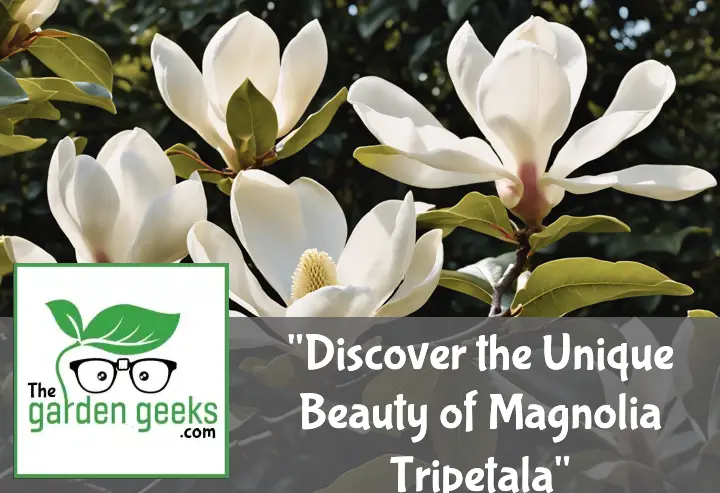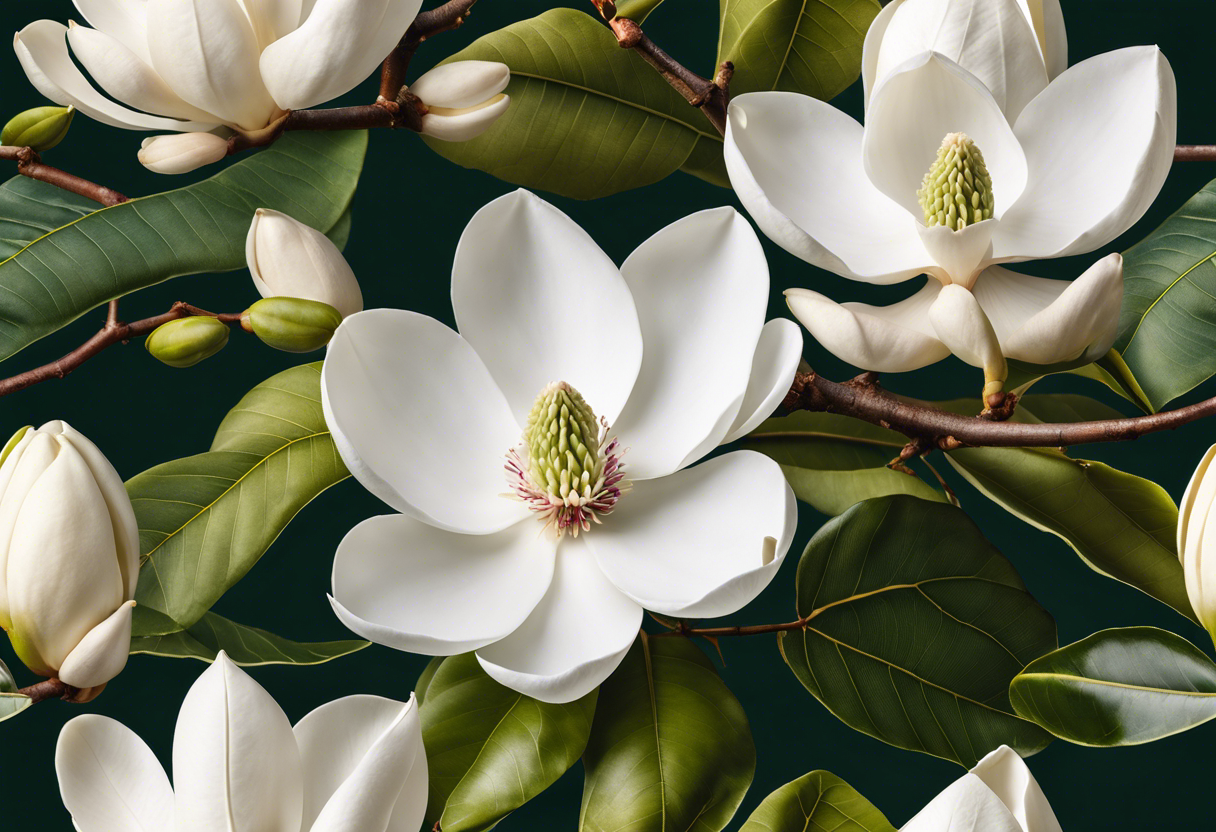Ever stumbled upon a tree that’s both peculiar and fascinating? That was my first encounter with the Magnolia Tripetala, also known as the umbrella magnolia. This unique species, with its eye-catching features, had me intrigued from the get-go.
In this blog post, we’ll dive into the world of Magnolia Tripetala – exploring its origins, distinctive characteristics, and ecological significance. So strap in folks! “Keep reading about Discover the Unique Beauty of Magnolia Tripetala.”
Key Takeaways
- Magnolia Tripetala, also known as Umbrella Magnolia, is a unique tree species native to the eastern United States.
- It’s renowned for its large, umbrella-like leaves and distinctive, fragrant flowers that bloom in late spring.
- The tree can reach up to 15 meters in height and thrives in moist, well-drained soils.
- Its fruit is an aggregate of follicles that turn bright red when mature, attracting various bird species.
- Despite its beauty, it’s relatively underused in landscape design due to its large size and specific growing conditions.
What is Magnolia Tripetala?
Let’s talk about the Magnolia Tripetala, a unique beauty that’s often overlooked. This plant, full of Magnolia Tripetala facts, is a hidden gem in the botanical world.
Origin and Distribution
The Magnolia Tripetala has its roots (pun intended) in North America. It’s native to the eastern United States, from New York down to Florida and as far west as Illinois and Arkansas. That’s what we call a wide geographical range!
Now, if you’re wondering where is Magnolia Tripetala found? Well, it loves hanging out in moist, well-drained soils in valleys and along streams. So, if you’re on a hike near a water source in these regions, keep an eye out for this beauty.
Botanical Description
Now let’s get into the nitty-gritty – the botanical features of Magnolia Tripetala. This tree can grow up to 15-20 meters tall – that’s almost as tall as five giraffes stacked on top of each other!
What makes it stand out are its large leaves that can reach up to 24 inches long! Talk about making a statement! And let’s not forget about its flowers. They’re creamy white with a hint of pink and give off a lemony scent.
The anatomy of a Magnolia Tripetala tree isn’t complete without mentioning its fruit. It produces reddish-brown aggregate fruits that attract all sorts of wildlife. So not only is it beautiful but also plays an important role in its ecosystem.
So there you have it – some quick identifying features of a Magnolia tripetaila for your next nature walk or garden planning session!
Unique Features of Magnolia Tripetala
The Magnolia Tripetala is a marvel in the plant world, boasting features that set it apart from its botanical kin. Let’s dive into what makes this beauty tick.
Unusual Leaf Arrangement
First off, let’s talk about those leaves! The Magnolia Tripetala leaves are arranged in a way that’s as unique as they come. Instead of the typical alternate or opposite arrangement seen in most plants, these leaves form a whorl at the end of the stem. This leaf arrangement creates an umbrella-like canopy, giving the tree its nickname – Umbrella Magnolia. Now that’s some unique foliage!
Distinctive Flower Structure
Next up on our tour de Magnolia is its flowers. The Magnolia Tripetala flowers are nothing short of spectacular. They have this distinctive structure with large petals forming a sort of trumpet shape (hence ‘tripetala’). These beautiful blooms, often creamy white with a hint of pink, add to the overall charm and elegance of this tree.
Fruit and Seed Characteristics
Last but not least, we’ve got the fruits and seeds. The Magnolia Tripetala fruits are cone-shaped aggregates that turn bright red when ripe. Inside these fruits are seeds with vibrant red coats – quite a sight during autumn! These seed characteristics play a crucial role in plant reproduction, ensuring the survival and propagation of this magnificent species.
The Ecological Role of Magnolia Tripetala
The Magnolia Tripetala, a true spectacle in the world of flora, plays a significant role in its ecological surroundings. Its unique characteristics contribute to the biodiversity and overall health of the environment.
Habitat Preferences
This beauty, known as Magnolia Tripetala, thrives best in certain habitats. It’s pretty picky, you see. Prefers well-drained soils and can’t stand waterlogged conditions.
Now, when it comes to climate, this plant is quite tolerant. It can handle a bit of cold but really loves those temperate regions. Native to Eastern North America, it’s found its sweet spot there.
Role in Ecosystem
Alright, let’s talk about how this plant contributes to its ecosystem. First off, it’s a real crowd-pleaser for wildlife. Birds and insects just love it!
But that’s not all! This plant also plays a part in nutrient cycling. Its fallen leaves decompose and return vital nutrients back into the soil. So yeah, the Magnolia Tripetala is not just another pretty face; it helps maintain an ecological balance too!
The Cultural Significance of Magnolia Tripetala
The cultural importance of Magnolia Tripetala is undeniable. It’s not just a pretty face in the plant kingdom, but also a symbol of resilience and adaptability.
Use in Landscaping and Gardening
When it comes to landscaping and gardening, Magnolia Tripetala is a showstopper. Its unique beauty adds an aesthetic appeal that’s hard to match. With its large, umbrella-like leaves and fragrant flowers, it’s like having your own piece of paradise right at home.
But don’t be fooled by its delicate appearance. This plant is tough as nails! It thrives in various conditions and requires minimal maintenance. So if you’re looking for a low-maintenance plant with high visual impact, consider adding some Magnolia Tripetala to your garden.
Medicinal Uses
Now let’s talk about the medicinal properties of Magnolia Tripetala. Historically, this plant has been used for various health-related purposes. From treating fever to soothing stomach problems, it’s been there done that!
In modern times, research has found potential uses for Magnolia Tripetala in treating anxiety and inflammation. But remember folks, self-medication isn’t cool! Always consult with a healthcare professional before trying any new treatments.
So there you have it – from beautifying landscapes to potentially healing ailments, the societal impact of Magnolia Tripetala is truly remarkable!
How to Grow and Care for Magnolia Tripetala
Growing and caring for Magnolia Tripetala is a rewarding endeavor. With the right conditions and a little TLC, this unique beauty will thrive in your garden.
Ideal Growing Conditions
To start off, Magnolia Tripetala loves a spot with full sun or partial shade. It’s not too picky about light, but it does appreciate some afternoon shade in hot climates.
The soil should be rich, well-drained, and slightly acidic. This tree isn’t a fan of heavy clay or overly sandy soils. So if you’ve got that kind of soil, consider amending it with organic matter.
Watering needs are moderate. The Magnolia Tripetala likes its soil to stay moist but not waterlogged. Overwatering can lead to root rot, so be careful!
When it comes to temperature, this plant is pretty hardy. It can tolerate cold winters as long as it’s properly mulched.
Common Pests and Diseases
Like any other plant, Magnolia Tripetala has its share of pests and diseases. Scale insects and magnolia weevils can sometimes be an issue.
Scale insects suck sap from the leaves causing them to yellow and drop prematurely. If you notice these critters on your tree, consider using an insecticidal soap or oil.
Magnolia weevils are another pest that can cause damage by feeding on the leaves and buds of the tree. These pests can be controlled with appropriate insecticides.
As for diseases, Magnolia Tripetala is relatively disease-resistant but can occasionally suffer from leaf spot or powdery mildew. Regular pruning helps increase air circulation which reduces the chance of these diseases taking hold.
Remember folks! Prevention is better than cure when dealing with pests and diseases in your garden!
To Wrap Up
Just like a surprise party hidden in a quiet library, the Magnolia Tripetala is an unexpected delight in the plant world. Its unique beauty, from its umbrella-like leaves to its trumpet-shaped flowers, is as eye-catching as a peacock at a pigeon gathering.
So why not add some pizzazz to your garden? Think of it as inviting a rockstar to your backyard concert. Visit this link and let the Magnolia Tripetala steal the show!





